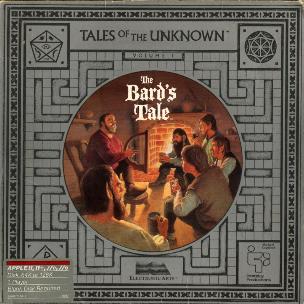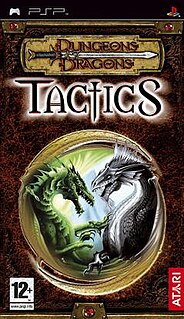Shannara is a series of high fantasy novels written by Terry Brooks, beginning with The Sword of Shannara in 1977 and concluding with The Last Druid which was released in October 2020; there is also a prequel, First King of Shannara. The series blends magic and primitive technology and is set in the Four Lands, which are identified as Earth long after civilization was destroyed in a chemical and nuclear holocaust called the Great Wars. By the time of the prequel First King of Shannara, the world had reverted to a pre-industrial state and magic had re-emerged to supplement science.

Pool of Radiance is a role-playing video game developed and published by Strategic Simulations, Inc (SSI) in 1988. It was the first adaptation of TSR's Advanced Dungeons & Dragons (AD&D) fantasy role-playing game for home computers, becoming the first episode in a four-part series of D&D computer adventure games. The other games in the "Gold Box" series used the game engine pioneered in Pool of Radiance, as did later D&D titles such as the Neverwinter Nights online game. Pool of Radiance takes place in the Forgotten Realms fantasy setting, with the action centered in and around the port city of Phlan.

The Bard's Tale is a fantasy role-playing video game designed and programmed by Michael Cranford for the Apple II. It was produced by Interplay Productions in 1985 and distributed by Electronic Arts. The game was ported to the Commodore 64, Apple IIGS, ZX Spectrum, Amstrad CPC, Amiga, Atari ST, MS-DOS, Macintosh, and NES. It spawned The Bard's Tale series of games and books. The earliest editions of the game used a series title of Tales of the Unknown, but this title was dropped for later ports of The Bard's Tale and subsequent games in the series.

The magic in Dungeons & Dragons consists of the spells and magic systems used in the settings of the role-playing game Dungeons & Dragons (D&D). D&D defined the genre of fantasy role-playing games, and remains the most popular table-top version. Many of the original concepts have become widely used in the role-playing community across many different fictional worlds, as well as across all manner of popular media including books, board games, video games, and films.
The druid is a playable character class in the Dungeons & Dragons fantasy role-playing game. Druids wield nature-themed magic. Unlike clerics, druids do not have special powers against undead and, in some editions, cannot use metal armor. Druids have a unique ability that allows them to change into various animal forms, and various other qualities that assist them in natural settings.
Wizard, the wizard, or wizards may refer to:
Several different editions of the Dungeons & Dragons (D&D) fantasy role-playing game have been produced since 1974. The current publisher of D&D, Wizards of the Coast, produces new materials only for the most current edition of the game. However, many D&D fans continue to play older versions of the game and some third-party companies continue to publish materials compatible with these older editions.
A bard is a minstrel in medieval Scottish, Irish, and Welsh societies; and later re-used by romantic writers.
A demon is a malevolent supernatural being in religion, occultism, mythology, folklore, and fiction.
The bard is a standard playable character class in many editions of the Dungeons & Dragons fantasy role-playing game. The bard class is versatile, capable of combat and of magic. Bards use their artistic talents to induce magical effects. The class is loosely based on the special magic that music holds in stories such as the Pied Piper of Hamelin, and in earlier versions was much more akin to being a Celtic Fili or a Norse Skald, although these elements have largely been removed in later editions. Listed inspirations for bards include Taliesin, Homer, Will Scarlet and Alan-a-Dale.
A character class is a fundamental part of the identity and nature of characters in the Dungeons & Dragons role-playing game. A character's capabilities, strengths, and weaknesses are largely defined by their class; choosing a class is one of the first steps a player takes to create a Dungeons & Dragons player character. A character's class affects a character's available skills and abilities. A well-rounded party of characters requires a variety of abilities offered by the classes found within the game.
The Wizard is a type of magical character class in certain role-playing games, including role-playing video games. Wizards are considered to be spellcasters who wield powerful spells, but are often physically weak as a trade-off. Wizards are commonly confused with similar offensive spellcasting classes such as the Warlock and the Necromancer. However, a Wizard's power is based on the arcane and a Warlock or Necromancer's power is based on darkness or death. Some exceptions exist as to Necromancers being different than Wizards, as in Dungeons And Dragons, Necromancer is a subclass of Wizard. Wizards are primarily based on wizards from assorted fantasy literature. Other terms used to describe the classification include Mage, Magician, and Magic User.
The iconic charactersin Dungeons & Dragons are a series of characters developed for the 3rd edition of the Dungeons & Dragons role-playing game used as recurring characters in illustrations and text explanations to illustrate archetypal D&D race and class combinations. In the case of a few classes, there is more than one iconic character, allowing for more varied iconic parties. They were created by and served as player characters for the developers during the creation and testing of the Third Edition rules.
Sword World RPG is a Japanese tabletop role-playing game created by Group SNE. 10 million copies of the related books including rulebooks, novels and replays have been sold. The game was first published in 1989; the updated edition, known as the "Sword World 2.0", was published in 2008; the current edition "Sword World 2.5" was published in 2018.

Dungeons & Dragons Tactics is a tactical role-playing game released on the PlayStation Portable handheld video game console. It is set in the world of Dungeons & Dragons and uses a strict interpretation of the Dungeons & Dragons 3.5 Edition rule set.
A necromancer is a person who practices necromancy, a discipline of black magic used to communicate with the dead to foretell the future.
Sources and influences on the development of Dungeons & Dragons include fantasy fiction, mythology, and wargaming rules, among others.
The Furies (Erinyes) are the deities of vengeance in Greek mythology.
Elements of Irish mythology often appear in popular culture. Sometimes similar themes are utilized in new narratives; other times the only similarity is the use of a name from Irish mythology, applied to a completely different character and story.

To Heart 2: Dungeon Travelers is a role-playing video game developed by Sting and published by Aquaplus on June 30, 2011 for the PlayStation Portable in Japan only. The game is a spin-off from Leaf's To Heart 2 franchise, and gameplay highly resembles another To Heart 2 based mini game from the Windows visual novel Manaka de Ikuno!!, titled Final Dragon Chronicle: Guilty Requiem.




